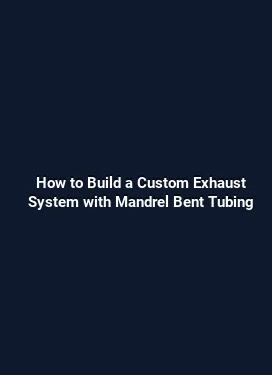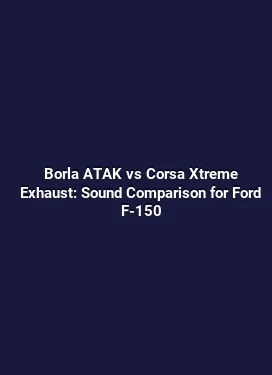How to Install a 3-Inch Exhaust System on Honda Civic Type R FK8
Upgrading the exhaust on a Honda Civic Type R FK8 to a 3-inch diameter can unlock improved exhaust flow, enhanced engine response, and a more engaging soundtrack. This guide walks through a detailed, practical installation process that covers parts selection, fitment considerations, tool lists, and step-by-step procedures. The aim is to provide actionable insight for a clean, reliable upgrade that preserves drivability and reliability under daily usage and track-friendly conditions.
Assessing Fitment and Planning the Upgrade

Before any wrench is turned, evaluate how a 3-inch exhaust will interact with the FK8’s chassis, undercarriage clearance, and existing emission control components. The FK8 uses a turbocharged engine and a relatively compact sheet-metal exhaust routing compared to larger chassis. A 3-inch system is a common upgrade size for maximizing flow while maintaining ground clearance and catalytic compatibility. Measuring the available space, determining whether a cat-back or full system approach is desired, and confirming compatibility with the vehicle’s ECU calibration are essential steps in the planning phase.
Identify the target configuration: a cat-back system retains the factory downpipe and catalytic converter location while increasing diameter downstream. A full 3-inch system involves either a new downpipe or a redesigned catalytic assembly. The choice influences turbo spool characteristics, backpressure dynamics, and potential gains. For most FK8 drivers seeking a blend of performance and daily drivability, a cat-back 3-inch setup paired with a properly tuned exhaust tip and hanger arrangement offers a favorable balance.
Key Components of a 3-Inch Exhaust System
A typical 3-inch FK8 exhaust kit includes mandrel-bent tubing, a mid-pipe section, a resonator or muffler chamber, hangers, clamps, gaskets, and a tailpipe assembly. The quality of each component affects fitment, durability, and acoustics. Look for predictable mandrel bending radii, corrosion-resistant materials such as T304 stainless steel, and precise flange interfaces that align with the factory mounting points.
The central elements to evaluate are the pipe diameter, joint design, and muffling strategy. A true 3-inch pipe maintains constant diameter through the mid-pipe and muffler region to minimize flow restrictions. Joints often use slip-fit and V-band connections for serviceability and consistent seal integrity. If a resonator is included, consider its location and internal baffling, as it will influence tone and amplitude at different RPM ranges.
Material and Build Quality

Sourcing a system built from aerospace-grade stainless steel, typically 304 or 316 grade, ensures resistance to heat and corrosion. Welds should be uniform with smooth bead contours that avoid creating hot spots or stress concentrations. A robust hangar design prevents vibration and reduces exhaust movement during cornering or rough road surfaces. The finish on the exhaust tips also contributes to appearance and corrosion resistance, particularly in areas prone to road salt exposure.
Fitment Considerations and Clearance
Clearance is critical for the FK8’s undercarriage components, including the subframe, differential area, and rear suspension links. A 3-inch cat-back typically requires careful routing to avoid contact with the sway bar, fuel lines, or heat shields. Verify that the exhaust tips align symmetrically with the bumper cutouts and maintain a consistent ground clearance across the vehicle’s length. Some kits provide adjustable hangers or multiple mounting positions to tailor fitment and sound profile to personal preference.
Tools, Safety, and Preparation
As with any automotive modification, safety and preparation are essential. Gather a complete toolset including a full socket set, torque wrench, jack stands, wheel chocks, penetrating oil, and a rubber mallet or soft-faced hammer. A car ramps setup can ease access but ensure stability and a secure parking brake. When working with the exhaust, cool-down periods and protective gloves are advisable due to high thermal mass in the system and surrounding components.
Prior to removal, inspect the existing exhaust hangers for wear and replace any cracked or stretched rubbers. Lubricants like penetrating oil help break loose seized fasteners but avoid oil on gasket surfaces to preserve seal integrity. If the plan includes a downpipe or catalytic changes, be prepared for potential changes in exhaust gas temperature and backpressure characteristics that may affect engine behavior and O2 sensor readings.
Step-by-Step Installation Process
The following sequence outlines a practical approach for a cat-back 3-inch installation on the FK8. Adhere to all safety guidelines and consult the manufacturer’s installation manual for any system-specific instructions or torque specifications.
1) Prepare the vehicle: Park on a level surface, engage the parking brake, and place wheel chocks. Raise the car on a hydraulic lift or ramps and support with jack stands at the pinch welds. Remove the rear wheels if needed for easier access to exhaust hangers and clamps.
2) Remove the existing exhaust section: Apply penetrating oil to hangers and bolts to ease removal. Use penetrating oil, then detach the muffler clamp and exhaust hangers that connect the existing system to the undercarriage. Support the muffler to prevent sudden drops and avoid bending the exhaust pipe. Once freed, gently slide the system back toward the rear and remove all sections as needed.
3) Compare the new components: Lay out the 3-inch cat-back components to confirm fitment; identify any heat shields or bracketry that may require relocation. Check for the correct orientation of the muffler or resonator, ensuring the inlet and outlet align with the mid-pipe and tailpipe geometries.
4) Install the mid-pipe and resonator: Begin with the mid-pipe assembly, using new gaskets and clamps as specified by the kit. Tighten the slip-fit or flange connections incrementally to avoid misalignment. Position the resonator to achieve the desired acoustic profile and ensure clearance from adjacent components. Re-check positions of hangers and ensure even weight distribution along the exhaust path.
5) Fit the muffler and tailpipe: Attach the muffler to the mid-pipe using the designated connectors. Align the tailpipe with the bumper cutouts and evenly distribute the exhaust tip position on both sides to maintain symmetry. Tighten clamps gradually, check for cold-curing seals, and ensure no contact with the chassis, fuel lines, or heat shields.
6) Reconnect sensors and electrical connections: If the upgrade involves any oxygen sensor relocation or wiring harnesses, reconnect them following the kit’s instructions. Verify that sensor connectors snap securely and that wiring pathways avoid hot surfaces or sharp edges that could cause wear over time.
7) Final checks and torque sequence: With the system loosely assembled, perform a final visual inspection for clearance at all points. Re-check all fasteners and ensure friendly, even clamping without overtightening. Re-install wheels, lower the vehicle, and perform a test run at low speed to verify there are no rattles or contacts. If a heat shield was relocated, confirm it retains proper clearance and thermal protection.
Sound, Power, and Drivability Considerations
Upgrading to a 3-inch exhaust generally influences tone, volume, and throttle response. A larger diameter reduces backpressure and can enable a more aggressive exhaust note, especially at higher RPM. However, the FK8’s turbocharged engine responds to intake and exhaust dynamics; a well-matched system prevents unwanted drone at cruising speeds while preserving a lively sense of immediacy during acceleration. In many builds, you’ll notice a slightly deeper growl at idle and a more pronounced intake roar under load, particularly when paired with a performance downpipe or tuned ECU calibration.
Performance-wise, a properly designed 3-inch system can offer incremental gains in flow but should be balanced with the vehicle’s turbocharger characteristics. It is common to see slight improvements in horsepower and torque in mid-to-high RPM ranges, with the most noticeable changes dependent on the rest of the powertrain and internal tolerances. If the upgrade is paired with exhaust tuning via a dyno-tuned mapping or a calibrated ECU, the system can unlock more consistent power delivery across a wider RPM window.
Maintenance and Longevity
Like any aftermarket exhaust, routine inspection is key to long-term reliability. Check for loose clamps, corrosion on stainless surfaces, and heat shield integrity. Over time, vibration and thermal cycling can cause hanger wear or slight misalignment; periodic checks every 6–12 months are prudent, particularly for drivers who frequently traverse rough roads or engage in spirited driving. Cleaning the exhaust tips with non-abrasive cleaners helps maintain appearance and prevent tarnish, especially in coastal or salted-road environments.
Beyond the hardware, maintain the surrounding undercarriage with rust protection in susceptible regions. If you live in a climate with heavy road salt, consider applying a rust-inhibiting coating to the hanger brackets and the tailpipe exterior to extend the system’s longevity without compromising its performance or cosmetic appeal. Proper maintenance supports stable exhaust routing, preserves acoustic characteristics, and helps retain resale value.
Tips for a Professional-Grade Finish
Achieving a factory-like finish with aftermarket 3-inch systems requires attention to detail. Use anti-seize on bolt threads to facilitate future serviceability and reduce the risk of galling during assembly. Confirm that the tailpipe tips are perfectly parallel to the bumper plane and aligned to maintain a symmetrical look. If the packaging includes exhaust clamps, ensure the surfaces are clean before installation to prevent leaks and uneven seating. A light coating of high-temperature anti-seize on gasket surfaces can aid in achieving a reliable seal after the first heat cycle.
For enthusiasts who crave a more aggressive presence, consider a resonator delete option if the kit supports it. This modification can intensify the sound and alter resonance characteristics, though it may also increase cabin drone at certain RPM ranges. Always test-drive the vehicle in a controlled environment after any resonance-related changes to confirm that the audible and driving experience remains within personal preferences and local noise regulations.
Final Fitment Review and Quality Assurance
After installation, perform a thorough road test to evaluate fitment over typical driving surfaces. Listen for rattles, ensure there is no contact with the fuel lines or suspension components, and verify that turbocharger spool behavior remains smooth. If the vehicle exhibits unusual vibrations or a misalignment during acceleration, recheck all hangers and clamp torque values. A well-executed 3-inch exhaust upgrade should feel cohesive with the FK8’s overall performance intent, delivering confident throttle response and a refined, purposeful exhaust note across the driving spectrum.
With proper planning, precise fitment, and careful tensioning of fasteners, a 3-inch exhaust system can be a compelling upgrade for Honda Civic Type R FK8 owners seeking enhanced flow, a distinct sound profile, and improved power delivery. The key is to align component quality with careful assembly practices and mindful tuning to ensure a reliable, enjoyable driving experience that respects both performance goals and daily usability.






